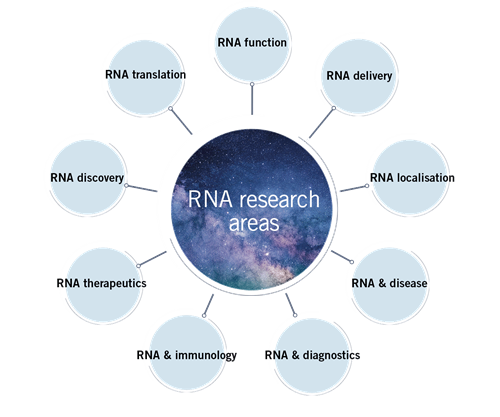Overview - What is whole transcriptome sequencing?
To obtain a truly complete picture of transcriptomes, all RNA transcripts of an organism need to be taken into account, regardless of whether the RNA is coding or non-coding. Therefore, the entire RNA of an organism must be isolated. Since ribosomal RNA (rRNA) accounts for as much as 98% of the transcriptome, the rRNA is often depleted in order to optimise the number of reads covering the actual RNA of interest.
Whole transcriptome sequencing, also called total RNA-Seq, is the ideal approach to gain a complete picture of the entire transcriptomes of you organism of interest.
Applications - What are the advantages of whole transcriptome sequencing?
Whole transcriptome sequencing is an advantageous technique for researchers looking to:
- Obtain the most comprehensive genome-wide view of the transcriptome
- Map genes by untranslated region (UTR) and by characterising exon boundaries
- Analyse splicing and alternative splicing mechanisms
- Investigate transcriptomes of human and non-human origin

Workflow - Methods & technologies for whole transcriptome sequencing
RNA-Seq approaches in general have similar workflow. First, RNA is isolated and reverse transcribed into cDNA. This cDNA is then fragmented, and adapters are ligated to the cDNA fragments that finally undergo single-end or paired-end sequencing. Subsequently, the reads are aligned to a reference transcriptome or assembled de novo to reveal a detailed profile at single base resolution.
Total RNA-Seq differs from other transcriptome sequencing strategies as the method allows for sequencing of both coding and non-coding RNA. Rather than undergoing polyA+ selection that targets the mRNA species, the whole RNA is often subjected to rRNA depletion instead. As rRNA makes up a large percentage of the entire RNA, reduction of rRNA helps allocate more sequencing reads to transcripts of interest. cDNA is synthesised from the rest of the rRNA-depleted RNA. Optionally, strand-specific information during downstream processing can be provided. The cDNA is then treated as in all other RNA-Seq workflows.
Whole transcriptome sequencing vs. mRNA sequencing
Long RNA sequencing techniques, whole-transcriptome sequencing and mRNA sequencing are all powerful methods for transcriptome profiling. Ultimately, the objective dictates the transcriptome sequencing approach that needs to be used.
Total RNA-Seq is used when all RNA transcripts of an organism must be analysed. This approach can be used for exploring all RNA species. mRNA sequencing, on the other hand, can only be used for analysing the coding part of the genome. Since mRNA makes up only 1% to 4% of the transcriptome, enrichment of mRNA can greatly increase the amount of reads dedicated to exon analysis. Importantly, the sensitivity towards mRNA transcripts expressed at lower levels is also increased.
Small non-coding RNAs are analysed through a third transcriptome sequencing approach for microRNA (15-30 nucleotides) and small RNA (30 to 200 nucleotides).
Scientific expertise: Whole transcriptome sequencing
Eurofins Genomics is a trusted provider of transcriptome sequencing services, including Whole transcriptome sequencing. With extended sequencing coverage and our excellent BioIT analysis, we can assist you discover new variants and alternative splicing mechanisms in nearly any genome of interest. With Eurofins Genomics’ services, you can receive strand-specific data from transcriptomes without the need for well-defined reference sequences.
Products related to transcriptome sequencing
Would you like to explore the effects of all RNA transcripts on gene expression in your model organism? Then enjoy the most simple and accurate method of whole-transcriptome profiling using our sample-to-data package. We provide a full range of services starting with RNA isolation from various starting materials, expert library preparation, sequencing on Illumina platforms, professional BioIT analysis and a final and comprehensive data analysis report.
Choose the INVIEW Transcriptome product that is best suited to your sequencing Needs and take your research to the next level. Contact our Customer Care by email or toll-free phone for more information.
For de novo transcriptome analysis, our NGSelect product might be just what you need to take your research to the next level.
For transcriptome analysis of bacteria, our INVIEW Transcriptome Bacteria product is ideally suited.
Did you know that we at Eurofins Genomics have also great expertise in gene synthesis? Compile your own synthetic gene, from short double-stranded fragments, to optimised gene sequences, complex genes and complete gene libraries.